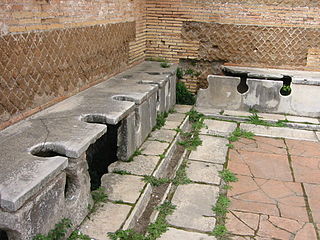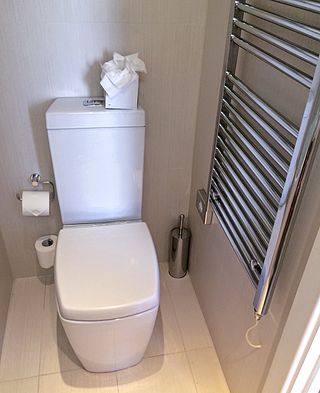
Compost is a mixture of ingredients used as plant fertilizer and to improve soil's physical, chemical and biological properties. It is commonly prepared by decomposing plant, food waste, recycling organic materials and manure. The resulting mixture is rich in plant nutrients and beneficial organisms, such as bacteria, protozoa, nematodes and fungi. Compost improves soil fertility in gardens, landscaping, horticulture, urban agriculture, and organic farming, reducing dependency on commercial chemical fertilizers. The benefits of compost include providing nutrients to crops as fertilizer, acting as a soil conditioner, increasing the humus or humic acid contents of the soil, and introducing beneficial microbes that help to suppress pathogens in the soil and reduce soil-borne diseases.

Vermicompost (vermi-compost) is the product of the decomposition process using various species of worms, usually red wigglers, white worms, and other earthworms, to create a mixture of decomposing vegetable or food waste, bedding materials, and vermicast. This process is called vermicomposting, while the rearing of worms for this purpose is called vermiculture.

Sanitation refers to public health conditions related to clean drinking water and treatment and disposal of human excreta and sewage. Preventing human contact with feces is part of sanitation, as is hand washing with soap. Sanitation systems aim to protect human health by providing a clean environment that will stop the transmission of disease, especially through the fecal–oral route. For example, diarrhea, a main cause of malnutrition and stunted growth in children, can be reduced through adequate sanitation. There are many other diseases which are easily transmitted in communities that have low levels of sanitation, such as ascariasis, cholera, hepatitis, polio, schistosomiasis, and trachoma, to name just a few.

A latrine is a toilet or an even simpler facility that is used as a toilet within a sanitation system. For example, it can be a communal trench in the earth in a camp to be used as emergency sanitation, a hole in the ground, or more advanced designs, including pour-flush systems.

A composting toilet is a type of dry toilet that treats human waste by a biological process called composting. This process leads to the decomposition of organic matter and turns human waste into compost-like material. Composting is carried out by microorganisms under controlled aerobic conditions. Most composting toilets use no water for flushing and are therefore called "dry toilets".

Night soil is a historically used euphemism for human excreta collected from cesspools, privies, pail closets, pit latrines, privy middens, septic tanks, etc. This material was removed from the immediate area, usually at night, by workers employed in this trade. Sometimes it could be transported out of towns and sold on as a fertilizer.
Human waste refers to the waste products of the human digestive system, menses, and human metabolism including urine and faeces. As part of a sanitation system that is in place, human waste is collected, transported, treated and disposed of or reused by one method or another, depending on the type of toilet being used, ability by the users to pay for services and other factors. Faecal sludge management is used to deal with fecal matter collected in on-site sanitation systems such as pit latrines and septic tanks.

A pit latrine, also known as pit toilet, is a type of toilet that collects human feces in a hole in the ground. Urine and feces enter the pit through a drop hole in the floor, which might be connected to a toilet seat or squatting pan for user comfort. Pit latrines can be built to function without water or they can have a water seal. When properly built and maintained, pit latrines can decrease the spread of disease by reducing the amount of human feces in the environment from open defecation. This decreases the transfer of pathogens between feces and food by flies. These pathogens are major causes of infectious diarrhea and intestinal worm infections. Infectious diarrhea resulted in about 700,000 deaths in children under five years old in 2011 and 250 million lost school days. Pit latrines are a low-cost method of separating feces from people.

A bucket toilet is a basic form of a dry toilet whereby a bucket (pail) is used to collect excreta. Usually, feces and urine are collected together in the same bucket, leading to odor issues. The bucket may be situated inside a dwelling, or in a nearby small structure.
Blackwater in a sanitation context denotes wastewater from toilets, which likely contains pathogens which may spread by the fecal–oral route. Blackwater can contain feces, urine, water and toilet paper from flush toilets. Blackwater is distinguished from greywater, which comes from sinks, baths, washing machines, and other kitchen appliances apart from toilets. Greywater results from washing food, clothing, dishes, as well as from showering or bathing.

Ecological sanitation, commonly abbreviated as ecosan, is an approach to sanitation provision which aims to safely reuse excreta in agriculture. It is an approach, rather than a technology or a device which is characterized by a desire to "close the loop", mainly for the nutrients and organic matter between sanitation and agriculture in a safe manner. One of the aims is to minimise the use of non-renewable resources. When properly designed and operated, ecosan systems provide a hygienically safe system to convert human excreta into nutrients to be returned to the soil, and water to be returned to the land. Ecosan is also called resource-oriented sanitation.

A flying toilet is a facetious name for a plastic bag that is used as a simple collection device for human faeces when there is a lack of proper toilets and people are forced to practise open defecation. The filled and tied plastic bags are then discarded in ditches or on the roadside. Associated especially with slums, they are called flying toilets "because when you have filled them, you throw them as far away as you can".

A toilet is a piece of sanitary hardware that collects human urine and feces, and sometimes toilet paper, usually for disposal. Flush toilets use water, while dry or non-flush toilets do not. They can be designed for a sitting position popular in Europe and North America with a toilet seat, with additional considerations for those with disabilities, or for a squatting posture more popular in Asia. In urban areas, flush toilets are usually connected to a sewer system that leads to septic tanks in isolated areas. The waste is known as blackwater and the combined effluent including other sources is sewage. Dry toilets are connected to a pit, removable container, composting chamber, or other storage and treatment device, including urine diversion with a urine-diverting toilet.

An arborloo is a simple type of composting toilet in which feces are collected in a shallow pit and a fruit tree is later planted in the fertile soil of the full pit. Arborloos have: a pit like a pit latrine but less deep; a concrete, ferrocement or other strong floor; a superstructure to provide privacy; and possibly a ring beam to protect the pit from collapsing. The pit should remain well above the water table in the soil, so as to not contaminate groundwater.

Urine diversion, also called urine separation or source separation, refers to the separate collection of human urine and feces at the point of their production, i.e. at the toilet or urinal. Separation of urine from feces allows human waste to be treated separately and used as a potential resource. Applications are typically found where connection to a sewer-based sanitation system is not available or areas where water supplies are limited.

A dry toilet is a toilet which, unlike a flush toilet, does not use flush water. Dry toilets do not use water to move excreta along or block odors. They do not produce sewage, and are not connected to a sewer system or septic tank. Instead, excreta falls through a drop hole.
Resource recovery is using wastes as an input material to create valuable products as new outputs. The aim is to reduce the amount of waste generated, thereby reducing the need for landfill space, and optimising the values created from waste. Resource recovery delays the need to use raw materials in the manufacturing process. Materials found in municipal solid waste, construction and demolition waste, commercial waste and industrial wastes can be used to recover resources for the manufacturing of new materials and products. Plastic, paper, aluminium, glass and metal are examples of where value can be found in waste.

A urine-diverting dry toilet (UDDT) is a type of dry toilet with urine diversion that can be used to provide safe, affordable sanitation in a variety of contexts worldwide. The separate collection of feces and urine without any flush water has many advantages, such as odor-free operation and pathogen reduction by drying. While dried feces and urine harvested from UDDTs can be and routinely are used in agriculture, many UDDT installations do not apply any sort of recovery scheme. The UDDT is an example of a technology that can be used to achieve a sustainable sanitation system. This dry excreta management system is an alternative to pit latrines and flush toilets, especially where water is scarce, a connection to a sewer system and centralized wastewater treatment plant is not feasible or desired, fertilizer and soil conditioner are needed for agriculture, or groundwater pollution should be minimized.

Reuse of human excreta is the safe, beneficial use of treated human excreta after applying suitable treatment steps and risk management approaches that are customized for the intended reuse application. Beneficial uses of the treated excreta may focus on using the plant-available nutrients that are contained in the treated excreta. They may also make use of the organic matter and energy contained in the excreta. To a lesser extent, reuse of the excreta's water content might also take place, although this is better known as water reclamation from municipal wastewater. The intended reuse applications for the nutrient content may include: soil conditioner or fertilizer in agriculture or horticultural activities. Other reuse applications, which focus more on the organic matter content of the excreta, include use as a fuel source or as an energy source in the form of biogas.

Container-based sanitation refers to a sanitation system where toilets collect human excreta in sealable, removable containers that are transported to treatment facilities. This type of sanitation involves a commercial service which provides certain types of portable toilets, and delivers empty containers when picking up full ones. The service transports and safely disposes of or reuses collected excreta. The cost of collection of excreta is usually borne by the users. With suitable development, support and functioning partnerships, CBS can be used to provide low-income urban populations with safe collection, transport and treatment of excrement at a lower cost than installing and maintaining sewers. In most cases, CBS is based on the use of urine-diverting dry toilets.



















